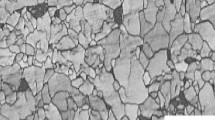Abstract
The oxidation behavior of a normalized 2.25Cr-1Mo steel tempered previously for 10 hr at different temperatures between 873 and 1023 K has been studied up to a maximum duration of 1000 hr in air at 773–973 K. The oxidation resistance of the steel was found to decrease significantly with the temperature of tempering. Tempering of this steel is reported to cause microstructural changes involving precipitation of Cr as carbides and a decrease in the effective (free) Cr contents, that could influence the oxidation resistance of the Cr-containing alloys. Relative compositions across the thickness of the oxide scales, as analyzed by SEM/EDX and SIMS, suggest that a less Cr-rich (and less protective) and thicker scale on the steel formed because previous tempering caused extensive depletion of free Cr.
Similar content being viewed by others
References
Application of 2.25Cr-1Mo steel for thick-walled pressure vessel,ASTM STP 755 (1982).
Proc. BNES International Conf. Ferritic Steels for Fast Reactor Steam Generators, London, 1978.
B. J. Cane and R. S. Fidler, Proc. BNES International Conf. Ferritic Steels for Fast Reactor Steam Generators, London, 1978, p. 193.
R. G. Baker and J. Nutting,JISI 192, 257 (1959).
K. Laha, K. B. S. Rao, and S. L. Mannan,Mater. Sci. Engng. A129, 183 (1990).
J. Leitnaker, R. L. Klueh, and W. R. Laing,Met. Trans. A 6A, 1949 (1975).
M. Murphy and G. Branch,JISI 209, 546 (1971).
J. Orr and F. R. Beckitt, in Proc. BNES International Conf. Ferritic Steels for Fast-Reactor Steam Generators, London, S. F. Pugh and E. A. Little, eds. (1978), p. 91.
J. Pilling and N. Ridley,Metall. Trans. A.13A, 557 (1982).
R. K. Singh Raman, and J. B. Gnanamoorthy,J. Mater. Sci. 27, 3435 (1992).
R. L. Klueh and J. F. King,Welding J.—Res. Suppl. 302s (1982).
R. K. Singh Raman, A. S. Khanna, B. K. Choudhary, and J. B. Gnanamoorthy,Mater. Sci. Engng. A148, 299 (1991).
N. J. Simms and J. A. Little,Oxid. Met. 27, 283 (1987).
N. J. Cory and T. M. Horrington,Oxid Met. 27, 237 (1987).
P. Roy and T. Lauritzen,Welding J.—Res. Suppl. 6, 45s (1984).
R. K. Singh Raman and J. B. Gnanamoorthy,Corros, Sci. (in press).
C. S. Lundin, S. C. Kelly, R. Menon, and B. J. Kruse, Stress-rupture behaviour of post-weld heat-treated 2.25Cr-1Mo steel weld metal,Welding Res. Council Bull. 315, 1–66 (1984).
R. K. Singh Raman, A. S. Khanna, and J. B. Gnanamoorthy, in Proc. Microscopy of Oxidation, Cambridge, M. J. Bennett and G. W. Lorimer, eds. (March 1990), p. 28.
Y. Shida, N. Ohtsunaka, J. Maruyama, N. Fujino, and H. Fujikawa, Proc. JIMS-3,High-Temp. Corros., Trans. Jpn. Inst. Met. 63, 631 (1983).
S. Leistikow, I. Wolf, and H. J. Grabke,Werkst. Korros. 38, 556 (1987).
Author information
Authors and Affiliations
Rights and permissions
About this article
Cite this article
Singh Raman, R.K., Gnanamoorthy, J.B. & Roy, S.K. Oxidation behavior of 2.25Cr-1Mo steel with prior tempering at different temperatures. Oxid Met 40, 21–36 (1993). https://doi.org/10.1007/BF00665257
Received:
Revised:
Issue Date:
DOI: https://doi.org/10.1007/BF00665257




